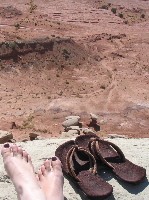AstroVino #8: Chardonnay
Last week's wine of choice was Chardonnay, the wine people generally get when they just ask for a "white wine" and the wine people request if they want to sound like connoisseurs but aren't sure what to order. In other words, the Chardonnay grape is either incredibly versatile or rather bland, depending on who you ask. Chardonnay wines are often aged in oak barrels, giving them a distinct flavor: from my experience the first evening of the wine class, I was afraid I wouldn't be able to survive this week, but evidently the Chardonnay the other evening was chosen as to "make a point." Most of the wines (aside from obvious exceptions) this week were fairly uninsulting, but none made my list of favorites.
We began the evening with two French Chardonnays: a 2004 Pouilly-Fuissé Propriété Marie-Antoinette Vincent from Fuissé, France and a 2005 Les Sétilles Chardonnay from Bourgogne, France. French Chardonnay is referred to as "white Burgandy." The Fuissé was described as "crisp" by others, and the Les Sétilles* was slightly spritzy, with a tart, almost lime-like flavor.
We then moved over to California, with a 2005 Rodney Strong Chardonnay from Sonoma County and a 2005 Kali Hart Chardonnay from Monterey County. The Rodney Strong was "aged in small oak barrels" and according to my notes, "smells oakier than smells." Erm ... perhaps I mean "smells oakier than tastes"? The oakiness did come out more strongly after the wine sat for a while, though. The Kali Hart was slightly sweeter and more "robust," with "fairly tropical" and "butterscotch" flavors. Californian Chardonnays are supposed to be good as sipping wines, independent of any food.
The interesting wines of the evening definitely came from South Australia. It is a bit too expensive for Australia to get genuine oak barrels for aging wine in, so generally wine is stored in large steel tanks, and wood chips are tossed in if an oaky flavor is desired. This distinction, though, did not play into the ... interestingness of our Australian wines. We tried a 2005 Hugo Unwooded Chardonnay from McLaren Vale and a 2003 Yalumba Eden Valley Wild Ferment Chardonnay. The Hugo, as it was "Unwooded," was not aged in oak at all, and served mostly to bring out just how oaky the other Chardonnays were (such as the Rodney Strong). Now, the Yalumba was quite an adventure. We have a group of 12 people, and the wine bottles are passed around one at a time, so more often than not, you get to hear what everyone else has to say about a certain wine before you get a chance to taste it. "Weird," is always an amusing comment to watch circulate the table, trailing after a certain bottle. You see, the Yalumba was a "Wild Ferment," which means that instead of letting cultivated yeasts do the work of fermenting the wine, the winemakers at Eden Valley chose to let wild yeasts native to the grapes themselves have at it. This proved to make the wine taste ... interesting. It smelled like a construction site, like tar perhaps?, or like "model airplane glue." It didn't taste quite as off as it smelled, but let's just say, it's more of a conversation piece than a nice sipping wine.
* Yes, it does make my spine twitch a little to refer to something as "the Les ..." but I do my best to ignore it.


No comments:
Post a Comment